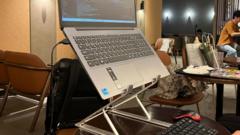In the bustling neighborhood of Daechi, Seoul, local cafe owner Hyun Sung-joo faces a challenge with the growing trend known as Cagongjok. This term describes young patrons who establish elaborate workstations in cafes, taking over resources like multiple laptops and power strips for hours on end. One customer recently overwhelmed Hyun’s cafe by occupying a single seat all day with a complex setup. "I ended up blocking off the power outlets," he lamented, highlighting the difficulties faced by cafe owners battling high rent and declining sales due to prolonged occupancy by a few.
Cafes in South Korea, particularly in student-populated areas, have become sanctuaries for those looking to study or work, far surpassing similar habits observed in Western countries. Starbucks Korea recently issued new guidelines aimed at curbing the extreme practices of some Cagongjok patrons. These measures include addressing instances where customers bring excessive equipment or leave tables unattended for extended periods. While the company will not enforce strict eviction policies, they plan to provide guidance to ensure a welcoming environment for all customers.
Even amidst the new protocols, patrons who study in cafes continue to frequent their favorite spots. One 18-year-old student, preparing for the rigorous university entrance exam known as “Suneung,” shared that she arrives at Starbucks around 11 am and stays until 10 pm, often leaving her belongings unattended to eat nearby. A visit to various Starbucks locations indicated compliance with the new policies, though some customers still left their items scattered, indicating a resistance to completely change behaviors.
The mixed reactions to the new Starbucks policy reflect a broader societal debate regarding Cagongjok's cultural significance. Many welcome the move as a way to reclaim cafe spaces for social interaction, while others feel it encroaches on their study habits. In a survey, 70% of Gen Z job seekers reported studying weekly in cafes, underscoring the trend's persistence.
While some independent cafes have started to implement stricter rules, such as a "No Study Zone," others provide facilities like ample power outlets and designated study spaces for those wishing to work longer hours. The cafe owner, Hyun, considers moderate usage acceptable, noting that most customers are conscientious enough to order additional items during their stay.
As for why many young South Koreans prefer cafes over libraries or home study environments, personal stories reveal underlying societal pressures. Yu-jin Mo, 29, finds comfort in cafes as a safe space, contrasting it with her troubled upbringing. She believes cafes offer a grounding ambience that other locations lack.
Professor Choi Ra-young from Ansan University emphasizes Cagongjok as a cultural phenomenon fueled by South Korea's competitive landscape. She advocates for creating inclusive spaces that accommodate both socializing and studying, suggesting the need for thoughtful guidelines to support this evolving youth culture.
In light of rapid cafe growth—an increase of 48% in five years—this ongoing discussion around the use of public spaces is likely to shape South Korea's future cafe culture.

















